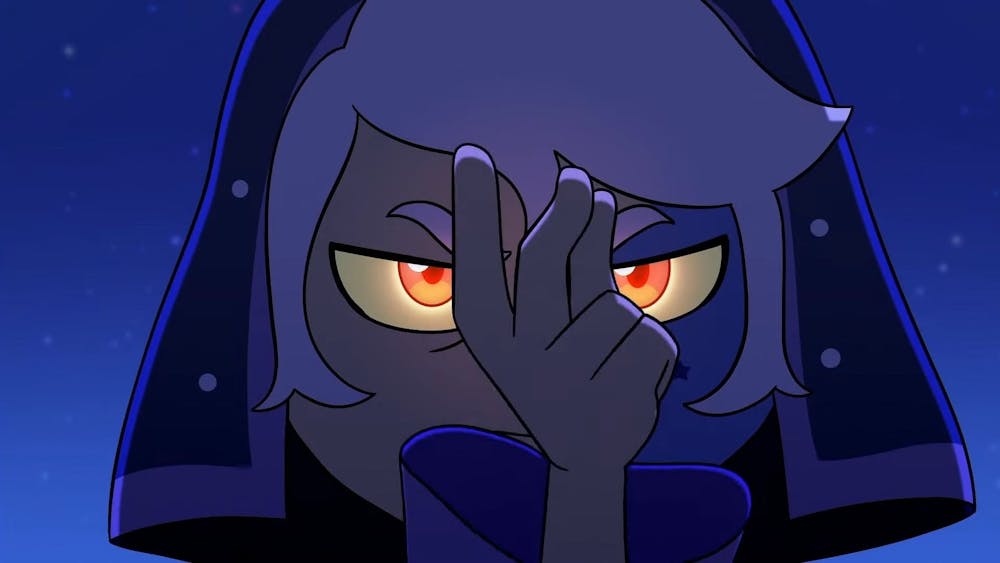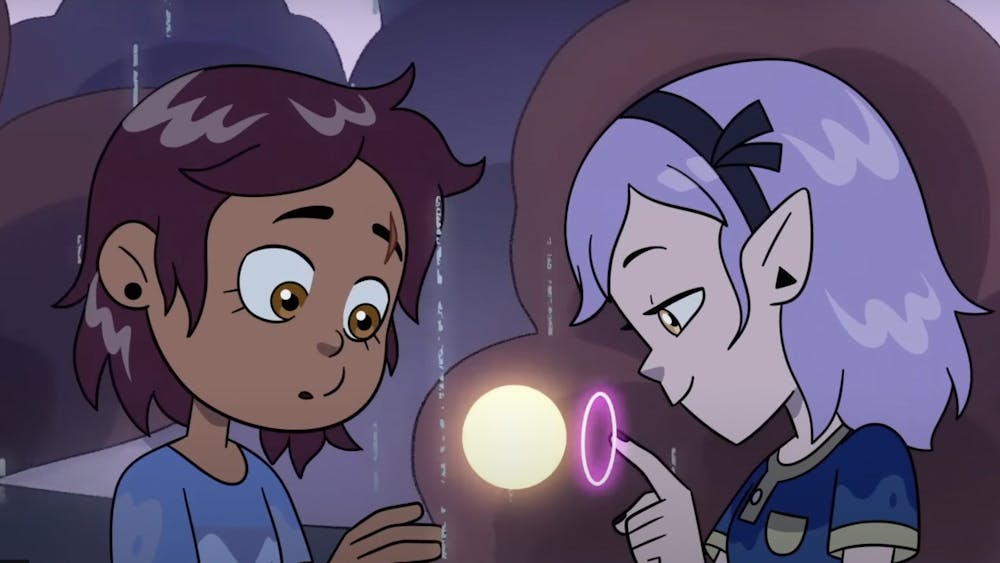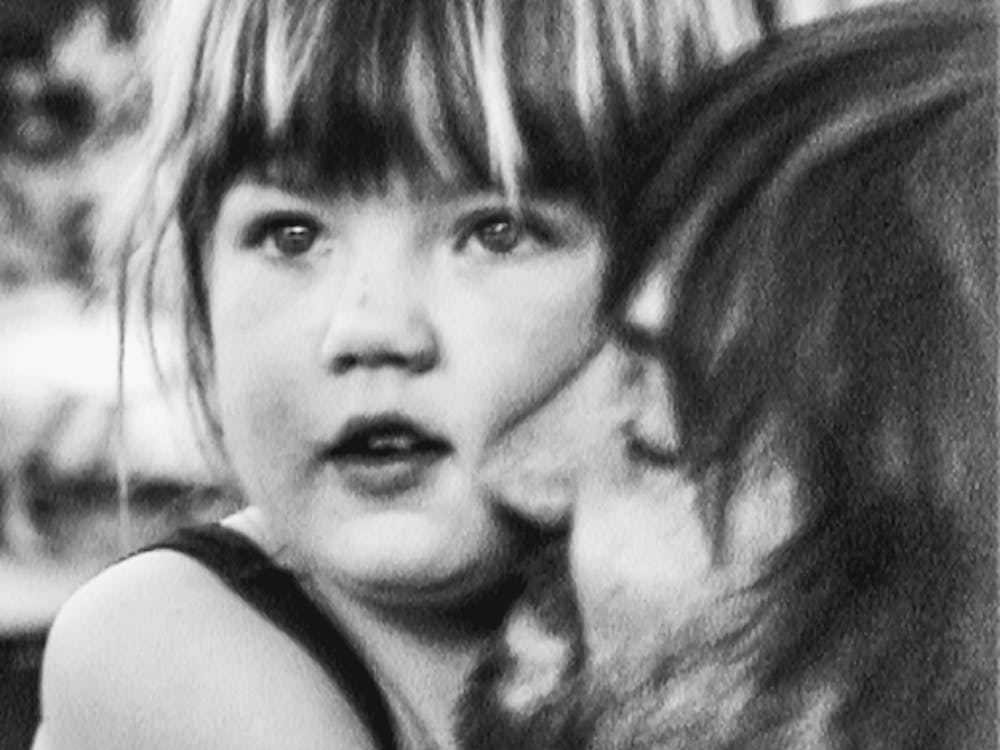The opinions and views expressed in this article are those of the author and do not reflect the opinion of Byte or Byte’s editorial board.
The conclusion of The Owl House has finally come, charging the fans and audience forward through the most heart-wrenching episodes. Within the combined total of over 100 minutes, the final two episodes balance storytelling, adventure, character growth, and sorrow in a way that few shows are able to do anymore, cementing its status as one of the best animated shows to date.
A walkthrough of it all
While I highly recommend watching the show and the episodes in their entirety, I do plan to walk through the plot of the final two episodes of season three and the show as a whole; “For the Future” and “Watching and Dreaming”.
“For the Future” picks up right after the end of the previous episode, with Luz (Sarah-Nicole Robles), her mother, and her friends arriving back to the Boiling Isles. But when they get through the portal, they see the Isles have changed, now childish and cute as a result of The Collector’s (Fryda Wolff) influence. This only makes the Crew worry as they each face their own traumas; Hunter (Zeno Robinson) with Flapjack’s death, Amity (Mae Whitman) and Gus (Isaac Ryan Brown) worrying about their families, Willow (Tati Gabrielle) trying to remain strong for everyone else as she fears for her family as well, and Luz blaming herself for everything that has happened.
They travel through the Isles, returning to the titular Owl House, finding it graffitied and emptied as they settle down for a moment to recoup. During this, Amity tells a worried Luz about how she had gotten Ghost, her palisman. She had to admit to what she wanted most, and in Amity’s case, she wanted to be able to choose her future for herself. Meanwhile, as the group rests in the Owl House, King (Alex Hirsch) plays with The Collector in a twisted and dramatized version of adventures from older episodes.
After resting for a time, Luz and the others bump into Mattholomule (Jorge Diaz), who takes them to a changed Hexside. It is now a place where refugees—mostly students—reside and are governed by Boscha (Eden Riegel) and her mysterious assistant Miki. And as the Crew plans within the halls of Hexside, Belos (Matthew Rhys) limps through the woods to an old hideout, haunted by visions of his brother as he imbues himself into the body of an unfinished grimwalker, which somewhat heals him. At Hexside, Mattholomule helps Luz and the Crew sneak into the magic photo classroom where they plan to extract a memory photo from Luz, which reveals the teleportation spell she had witnessed Belos use. Unfortunately, as they find the memory, they are attacked by Miki who happens to actually be Kikimora (Mela Lee), Belos’ old assistant.
Now slightly healed, Belos reaches the castle of The Collector and possesses the puppet of Raine, sneaking into The Collector’s room. While he is there, he manages to convince The Collector that King is plotting against him, which upsets The Collector. Back at Hexside, the Crew is thrown into the detention pit and Luz, Amity, Camila (Elizabeth Grullon), and Mattholomule are separated from the others as Kikimora begins to attack. During the fight, Camila botches an ice glyph, which separates Amity and Mattholomule from them.
On their own, Amity and Mattholomule are ambushed by Boscha, who seeks to have Amity return to the grudgby team with her. But Amity rejects her and Boscha tries to fight her, but is deftly beaten due to Mattholomule’s illusions. Meanwhile, Luz and Camila retreat into the woods in a desperate attempt to escape Kikimora. At this point, Luz believes she messed up again, but is confronted by Camila and told that messing up is a part of life. Camila goes on to admit her own mistakes and apologizes for trying to change Luz, which leads Luz to realize she only ever wanted to be understood. And this causes the palisman egg to hatch, forming a staff and an amorphous cloud.
Away from the others, Willow has begun to lose control of her magic due to her stress and self-doubt, causing Hunter and Gus to be trapped in vines. But Hunter teleports forward, talking to her and letting out everything he has been holding back. He encourages her to do the same, which she does. It isn’t long before the place begins to cave in and Hunter adeptly uses his newfound magic to save all three of them, realizing that he now has Flapjack’s magic.
Eventually, all the groups manage to reconvene, fighting Kikimora together before gathering and casting the teleportation spell which takes them to the Titan’s skull. When they arrive, Luz’s palisman finishes its transformation, culminating into a “snake shifter” she names Stringbean. But as everyone celebrates their small victory, The Collector and Belos observe them from above and Belos convinces The Collector that Luz has come to defeat him. And so, convinced by Belos, The Collector prepares to play a new game.
“Watching and Dreaming” continues directly where the last episode left off. Luz is separated from her loved ones as they are caught and hoisted away and she is left alone, enveloped in a bright light. She awakens to find herself sitting upon the Emperor’s throne within Belos’ castle, wearing his robes. And as she struggles to piece together what is going on, she is attacked by her friends and lover who are all blaming her for the situation they are in. But Luz soon realizes that they aren’t real, having been taken and used as puppets in a game in order to keep her away from Eda and King.
And during their moment of consciousness, her friends state that in order to save everyone, she needs to wake them up by “turning on the light,” handing her a light glyph. Using the light glyph, everything is revealed to be an illusion and Luz is freed of it, but finds Eda (Wendie Malick) and King caught in illusions of their own. So, using more glyphs, she frees them as well. Soon after, Belos convinces The Collector to play with them in person and The Collector agrees, challenging Luz, Eda, and King to several games. Though each time a game is played, he is beaten. Eventually, The Collector breaks down, revealing their loneliness and past betrayals.

Meanwhile, Belos travels to his castle, merging with the Titan’s heart and taking control of the Boiling Isles just as Amity, Gus, Hunter, and Willow escape their puppet forms. Luz, Eda, and King take The Collector to the Owl House and reminisce about their initial struggles of feeling unwelcome and not fitting in, deciding to not fit in together. And as the four travel around to various locations from the series, The Collector hears a rumbling like breath right as the Titan’s eye lights up, signaling Belos’ control. Quickly, they dart over to the castle, which has transformed into a giant monster. And remembering what Luz had said about kindness and forgiveness, The Collector tries to make peace with Belos. But Belos fires a blast at him and Luz rushes in to protect them, at the cost of taking the blast herself.
Mold—which had been spreading all across the Isles—soon consumes her and she dies, leaving behind small particles of light that float away. Witnessing the sacrifice and loss, Eda and King are overcome by rage and despair, unleashing their demon forms as they attack Belos. The Collector, however, is left confused and frightened as they finally begin to understand the concept of death.
In a dark void—the place between realms—Luz’s spirit begins to sink but is rescued by the Titan, King’s father. And after talking for a few moments, the Titan (Arin Hanson) offers his remaining life to help Luz defeat Belos once and for all, which she hesitantly accepts, being granted his powers as she is sent back to the Demon Realm where the battle between Belos and Eda and King continues.
Enraged, Belos attempts to crush The Collector, Eda, and King, but Luz—now partially a Titan witch—protects them. Together, they manage to escape and go to the Titan’s heart as The Collector goes to save those who had been turned into puppets. While at the heart, Luz uses all her strength to pull Belos from it, putting an end to his control over the Boiling Isles. And defeated, Belos tries to feign that he had been cursed to do all the terrible deeds he had done, but Luz refuses to believe his lies again. As boiling rain begins melting Belos, Eda, Raine (Avi Roque), and King stomp the rest of his goopy body out of existence, putting an end to his tyranny and reign of witch-hunting.
Now that the battle is over and the war is won, Luz, Eda, and King embrace each other, grateful to have survived. It doesn’t take long for the rebuilding process to begin, everyone has returned to normal and The Collector returns to the stars. Not long after, Luz realizes that glyphs no longer work due to the Titan giving up all of his energy.
Four years pass and Luz is packing up, preparing to head off to college in the Isles and excited to see her friends again. Heading through the new portal between Realms, many things have changed. Willow is a professional Flyer Derby player, Hunter carves palismen, Lilith is an architect with her own harpy form, and Amity is proficient in Abomination engineering. Bump has retired as Hexside’s principal while Alador, Darius, Eberwolf, and Raine work together to remove all coven sigils. Meanwhile, Eda has opened her own school, the University of Wild Magic, where Gus teaches culture of the Human Realm, and where Luz will be attending.
Upon returning to the Isles, Luz is surprised with a belated quinceañera befitting of the Isles. King reveals his newfound ability to power glyphs, much like his father once had, and says that The Collector had a gift for them. In the stars, a stunning light display is presented for Luz and her friends, where she expresses her gratitude to Eda and King for their support throughout the years.
As the episode—and show—concludes, everyone bids farewell and eagerly anticipates the upcoming adventures and obstacles they are sure to face.
A lesson that being weird is okay
The Owl House is a cartoon that surpasses expectations. It defies its naysayers (I’m looking at you, Disney) while providing to its audience a sense of comfort while weaving a fantastic story, regardless of the studio canceling it and shortening the third season. It’s a show that anyone can get into and enjoy, regardless of age. It’s a show that tells a message, one that we all could stand to hear in this day and age.
The third and final season of The Owl House manages to do something that many shows fail to do when pressed into these kinds of situations—sometimes even without being in this kind of situation. It manages to tell and finish a cohesive story that has very few flaws, continues to build the characters, and manages to bring fans around the world to tears.
In “For the Future,” the show not only tells us or shows us, but makes us feel the pain our favorite characters are going through. That’s because they are feelings real to everyone. Hunter is doing his best to cope with the loss of his best friend, Amity and Gus are worried for their families, Willow is doing her best to stay strong despite the fact that she is hurting inside, and Luz blames herself for putting her friends and the people she loves in these positions all because she made a mistake. These aren’t new feelings to be seen in a show, but they are handled properly—or as proper as you can get with a children’s show—and carefully, in a way that feels like natural progression for the characters. This in itself is quite the daunting task because you have to balance several characters’ emotions and feelings in such a short span of time. But as the story plays out, we see that balance for each character and see how, even if all of them are facing their own demons, they help each other out regardless.
As the story continues in “For the Future,” the show does well to not leave anything forgotten, coming back to various notes and tidbits that were mentioned earlier in the episode. Such as the moment when Luz, albeit unknowingly at the time, admitted that she simply wanted to be understood, the show draws back around to what Amity had said about palismen. Not only that, but the hatching palisman becomes key in helping defeat Kikimora. This ability to call back to various points in the show—either earlier in the episode or father back—helps the show to feel very cohesive and put together, showing the amount of thought and effort that went into making the show what it is.
However, in “Watching and Dreaming,” parts of this slip off as the show has to do its best to wrap up many plot threads while still feeling cohesive. And yet, it is still quite effective, even managing to give the audience somber callbacks to some of the earlier episodes of the show. And to be honest, if I had to call this episode anything, I would simply call it a “somber farewell”.

Throughout the episode, the main focus shifts to Luz as she saves her loved ones and the rest of the Boiling Isles (which is reasonable as Luz is the main protagonist), but done so at the expense of leaving Amity, Gus, Willow, Hunter, and even her own mother offscreen for most of the episode. It felt as though, with the focus shifted to hone in on Luz and the conclusion to her story, her friends (beyond King and Eda) were simply there to act as narrative tools to guide her through a desperate moment now that their traumas are essentially dealt with.
When it comes to the finale of Luz’s story, it was a fitting end and one that kept me on the edge of my seat, even getting me to shed a fair amount of tears when Luz sacrificed herself for The Collector and Eda and King fell into a sorrowful rage. The story shows us the final steps of Luz’s growth into who she is. Neither weird nor normal, just Luz—and that is exactly who she needed to be, someone who is compassionate for those she cares for, unafraid to charge into danger to right her wrongs and stand up for what is right. Someone who will give up everything if it means giving back to those who need it. Someone who can pull off cheesy one-liners which directly reference earlier episodes.
More importantly, though, the show overall manages to make small quirky things like being part of a fandom, writing fanfiction, and other traits that are often deemed weird feel completely normal. The same goes for being Hispanic or part of the LGBTQIA+ community. And simply put, that’s because they are. The way The Owl House handles these notions and concepts isn’t like how most shows try to present these topics—by making them the center of attention—rather, everything is pushed to the periphery, allowing narrative and character direction to guide the show while feeling natural. The show is a message to those who need to hear it that it's okay to be “weird,” because that is what makes you a person. To lose that is to be crammed into a limited and uniform box.
Is this what sorrow feels like?
Voice acting isn’t easy, especially when you are cramped for time and facing potential cancellation. And yet, in the midst of both of these setbacks facing season three, the actors and actresses of the show give what I would consider to be the performances of their lives. Each line delivered by nearly any character pulled upon some emotion within me. Whether it is Eda telling The Collector she is unsure she can hold the owl demon back after Luz’s death or Belos trying to claim he was cursed, each one was a pinnacle of voice acting.
Of course, that isn’t to say I didn’t have any issue with some of the voice acting, because I did. At the beginning of the final episode, “Watching and Dreaming,” the dialogue and the performances—though still quite exceptional—of Amity, Gus, Willow, Hunter, and even The Collector, felt a bit flat and too on-the-nose. And granted, it is reasonable as to why this happened, it still doesn’t excuse the fact that it felt off. Another spot that irked me a little—though for character it makes sense, I just wasn’t a fan of the delivery—was when Luz first arrives in her Titan witch form and she tries to give a one-off remark similar to her favorite fictional character, the Good Witch Azura. It honestly felt kinda cringey and bumped away the feeling of tensity that was there a few seconds prior.
“As scary as this is, it really does seem like you’ve matured.”
Anime. We’ve all seen them, we’ve all enjoyed them once or twice. But more importantly, we’ve seen how fluid a lot of anime action sequences can be, such as in the case of Attack on Titan or Castlevania. This is the same quality of animation for The Owl House and its action sequences. And frankly, it is beautiful. Especially as time has passed since the first season—yeah, the first season had them too—and more production value has been added to the show.
Within the final two episodes of the show, there are plenty of action shots we get. Quite often, they have a lot going on with them. Yet, with the fluid style and shot blocking of the sequences, we easily register what is occurring, taking it in as it comes without stopping at any point and having to ask ourselves what just happened.
Not only that, but the overall design of the show feels grander. The colors of the Boiling Isles feel very distinct and varied, shaded and sketched in a way that makes each set piece stand out in your mind. When we see the Boiling Isles in “For the Future,” we are met with bright and brilliant color palettes distinctive of childhood imagery and a sense of wonderment, similar to how Mabelland was very childish and distinct in Gravity Falls (though not as bright as that). But then, when The Collector’s effects wear off towards the end of the episode and for the majority of “Watching and Dreaming,” the palettes become muted and dark, matured in a way that helps illustrate the danger and sorrow residing throughout the Isles. And when the Boiling Isles returns back to near complete normal at the end of the episode, the palettes seem to mesh both the popping colors of childhood with the dull, muted colors of adulthood. Simply put, without even realizing, the colors of the Boiling Isles grew with Luz, maturing as she did.
And I think that’s wonderful.

Sources:
YouTube, YouTube, IMDb, IMDb, IMDb, IMDb, IMDb, IMDb, IMDb, IMDb, IMDb, IMDb, IMDb, IMDb, IMDb, IMDb, IMDb
Photo:
Contact Aaron Picklesimer with comments at ampicklesimer@bsu.edu


















